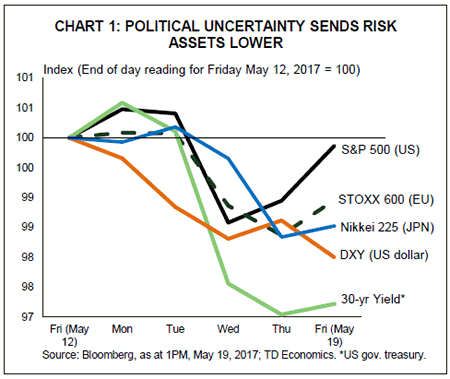HIGHLIGHTS OF THE WEEK
United States
- Investors perceived this week’s political developments in the U.S. as likely to delay the implementation of pro-growth policies. As a result, they risk assets sold off midweek in favor of gold and treasuries. Risk appetite appeared to make a comeback toward the end of the week along with some reversal in earlier trends, particularly among American equities.
- Underneath the political noise, the economy continued to emit mostly positive signals which included a rise in industrial production and capacity utilization, and falling jobless claims. Homebuilding appeared to be a soft spot at first glance, but the details reveal a better story.
- The Fed will keep an eye out for financial market stress, but is likely to continue focusing on signals from the economy. So far, the outlook for the second quarter remains solid, with growth currently tracking north of 3% annualized. As such, odds are still in favor of a June hike.
Canada
- The economic data out this week lifted our tracking for first quarter real GDP growth to 4% annualized. Real retail spending was up 1.2% in March, driven by spending on autos, while manufacturing shipments rose 0.2%. Both indicators were up 1.9% for the first quarter.
- While the Canadian economy is on track for its best three-quarter streak in almost three years, soft inflation and uncertainty over the near-term housing outlook are likely to keep the Bank of Canada on hold until early to mid next year.

UNITED STATES – CUTTING THROUGH POLITICAL NOISE
To say that political events dominated headlines this week may be somewhat of an understatement. The U.S. administration found itself in hot water once again over allegations of misconduct. Mounting political pressure reached a boiling point with the appointment of a special prosecutor to probe Trump-Russia ties. Financial markets perceived these developments as likely to delay the implementation of pro-growth policies such as tax reform and infrastructure spending, and quickly sold off risk assets. By midweek global stock markets followed the rapid decline in American indices (Chart 1). The trade-weighted U.S. dollar gave up all of its gains recorded since the U.S. election. In commodities, oil retained its upward trend and is poised to end the week above $50/bbl, buoyed by news that Russia and Saudi Arabia may extend their production cuts along with a report from EIA showing falling U.S. inventory levels.
Political turmoil was not limited to the U.S.. The president of Brazil was accused of bribery, sending both the national stock market and currency plunging 9% and 7% respectively the day after news broke. Under such global disorder investors poured their money in safe heaven assets, with gold gaining around $25/oz on the week and sending U.S. Treasury yields lower. However, risk appetite returned by the end of the week with some reversal in earlier trends, particularly among American equities. The heightened volatility was reflected in the VIX index, which spiked to a month high at midweek but subsided quickly thereafter.
Underneath the political noise, the economy continued to emit mostly positive signals. Industrial production rose 1.0% in April – the biggest monthly gain in more than three years. Capacity utilization also rose to 76.7% – the best level since late 2015, boding well for future business investment. Weekly jobless claims fell unexpectedly, with levels now resting near decade-lows seen as further signs of a tightening labor market. Lastly, homebuilding appeared to be a soft spot at first glance, but the details revealed a better story. The headline was pulled down by the volatile multifamily segment, while the single family segment retained its upward trend (Chart 2). The latter is a much larger and better indicator of economic conditions, and its advance is reflective of continued progress in the labor market. We expect this trend to continue as rising wages support household formation and demand for new homes.
Looking at the big picture there are two main points worth highlighting. First, investors will continue to pay close attention to political events because the implementation of pro-growth policies remains the cornerstone needed to validate today’s rich stock valuations. Intuitively, this suggests potential for further volatility in the weeks and months ahead. Second, the Fed too will keep an eye on such developments, not because it has placed much emphasis on the pro-growth policies to begin with, but rather because a market downturn could weigh on the real economy. Unless it sees concrete signs of this occurring, it is likely to continue focusing on underlying signals from the economy, particularly those related to inflation where recent readings have disappointed. So far, the outlook for the second quarter remains solid, with growth currently tracking north of 3% annualized. As a result, market participants will continue to price in a June Fed hike, with odds from CME Group currently pegged at 74%.


CANADA – A WINNING STREAK
Financial markets in Canada this week took their cue from rising political uncertainty in the United States. Interest rates, the loonie and the TSX all dipped. In contrast, the economic news was overwhelmingly positive. While still awaiting the final tally, we now have data on the vast majority of Canadian economic indicators for the first quarter of the year. Taking this into account, TD Economics estimates that Canadian real GDP grew by a stunning 4% annualized rate over the first three months of the year, following a solid end to 2016 and marking the best three quarter streak since 2013. While the Bank of Canada will remain on hold a little bit longer, the case for a rate hike as early as spring of next year is certainly mounting.
The Bank of Canada does not target economic growth directly, but rather inflation, which exhibits a lagged response to growth. This week’s consumer price report should give pause to anyone expecting an immediate central bank response. All measures of inflation watched most closely by the Bank of Canada are well below its 2% target and have been trending lower since January of this year, suggesting that the economy may have more slack than estimated. Still, with real GDP growth to hold at a healthy 2% to 2.5% pace following Q1’s tunrout, slack is being absorbed quickly. As a result, inflation is likely to move higher, reaching the bank’s target of 2% by late next year.
Moreover, while this week’s manufacturing report showed that the export-heavy sector is picking up momentum, economic growth is still largely being driven by domestic, interest-rate-sensitive sectors. The retail spending report this week pointed to a 2% gain in real spending in Q1, mostly due to sharp gains in auto sales. Meanwhile, record housing activity during the quarter supported construction activity and services related to home buying. Both personal consumption expenditure and residential investment are expected to account for all of the economic growth in the first quarter.
Beyond an anticipated temporary break in activity, the Canadian housing market is likely to remain a key driver of economic growth throughout our forecast horizon. In the near-term, TD economics believes that housing market activity is likely to back off due to a lagged response to changes to mortgage regulation implemented in October of last year, along with the introduction of a nonresident buyer’s tax and the expansion of rent control in Ontario. Indeed, market activity in Ontario reversed quickly in April, with a sharp 7% reduction in sales and a record spike in listings across the Greater Toronto Area. Following BC’s lead, we do think that markets in Ontario will take a pause over the next few months. However, markets in BC have also shown that the impact of such measures can be temporary and have very little impact on price growth. Housing activity is starting to bounce back in the province and home price growth is still holding at a hefty double-digit pace.
The bottom line is that while the economy is picking up steam, the combination of low inflation and more restrictive housing policy measures will bide the Bank of Canada some time to raise rates at least until the spring of next year.















